Contributory members are able to log private notes and comments about each site
Sites Anne T has logged. View this log as a table or view the most recent logs from everyone
Fowberry Park B
Date Added: 19th Aug 2014
Site Type: Rock Art
Country: England (Northumberland)
Visited: Yes on 17th Aug 2014. My rating: Condition 3 Ambience 5 Access 4

Fowberry Park E submitted by durhamnature on 2nd Sep 2012. Rock art, discovered in 1886 from Berwickshire Naturalists, via Archive.org.
(View photo, vote or add a comment)
Log Text: Having been disappointed at not being able to reach the Doddington Stone Cricle from the footpaths across the golf course (they seem to have vanished with an extension to the quarry) we were determined not to head home without having seen something. We spotted a number of other cup and ring marked rocks on the map around Fowberry Park, and headed for the easiest to find – opposite Fowberry Mains Farm.
There was sufficient room to park on the grass verge at the entrance to the footpath, and it was an easy walk up a slight hill, following a stone wall to the left. When we’d almost reached a field boundary to our right, there was a field gateway to the left giving access to outcrops of rock.
We thought we’d have to walk backwards to find our way around a spring, but the farmer has built a path over the small stream and the boggy part of the field, leading to a rocky outcrop immediately to the left on the far side of the stream. This outcrop did not appear to have any rock art.
Following the footpath up the slope to our right, we immediately came upon another, larger, outcrop, and the rock art sprang into view. I’d rate this as highly as the rock art stone at Roughting Linn.
The outcrop has been heavily quarried, but what is left is wonderful. The first set of cup marks we came across appear to have been painted in red ochre, although there seemed to be this red pigment on other parts of the rock, too.
Most astonishing was the long, almost grave-cover shaped rock covered in miniature marks in a row; on closer observation, the marks turned around the end of the rock, forming a tall, narrow U shape. I’ve not seen this formation of marks before.
There were other smaller rocks, buried in the turf, complete with rock art markings, too. The English Rock Art site records 8 different panels, and I’ve since printed off the images of each, together with the grid references (oh, for a GPS system to help!). I’m looking forward to going back to explore more.
Continuing up the hill towards Fowberry Moor, there is a homestead and a settlement. As it was blowing a gale, with gusts of 50 mph and possibly above, we didn’t linger too long. The map shows many other cup and ring marked rocks in the surrounding area, and
Most very definitely worth a second, third and possibly more trips to discover the richness of artefacts in this area.
Llanllawer Holy Well
Date Added: 26th Aug 2014
Site Type: Holy Well or Sacred Spring
Country: Wales (Pembrokeshire)
Visited: Yes on 21st Aug 2014. My rating: Condition 4 Ambience 3 Access 4

Llanllawer Holy Well submitted by vicky on 8th Jun 2004. This holy well lies adjacent to the road (from which it is signposted) in the village of Llanllawer. The spring (which was dry on a recent visit) was used for healing diseases of the eyes and also as a wishing well.
(View photo, vote or add a comment)
Log Text: Having visited the Pillar Stones, we drove the additional 2km through the village of Llanychaer to the Llanllawer Parish Church and Holy Well. There was a small lay-by opposite the gate to the field leading up to the church, so it was easy to park.
The church, which stands on top of the hill, is very obviously redundant, boarded up, and with loose slates. The only access to the church is through the field from the road.
The well is accessed by walking 50 yards further up the road, turning a left hand corner, where a stile/gate gives access to the Llanllawer Holy (Sainted) Well.
The well was dry when we saw it, but there is a clear channel to take water down hill. The ground was still boggy, although large stones made it easy to cross the channel to look inside the well.
Inside the well there were lots of tea-lights and tokens, and tokens had been hung from the gate to the well. It is clearly a place that is well revered, even today.
Llanllawer Church
Date Added: 26th Aug 2014
Site Type: Early Christian Sculptured Stone
Country: Wales (Pembrokeshire)
Visited: Yes on 21st Aug 2014. My rating: Condition 2 Ambience 3 Access 4
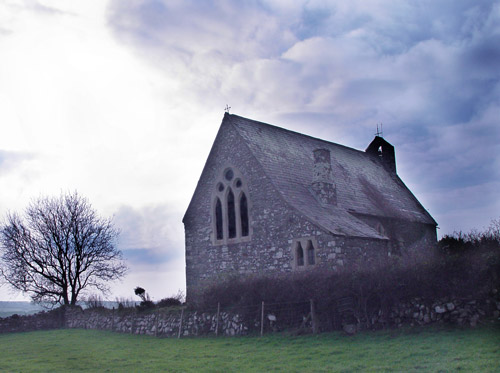
Llanllawer Church submitted by song on 27th Oct 2006. Llanllawer Church.
(View photo, vote or add a comment)
Log Text: The only access to the church is through a gate and a 100 yard walk through the field to the church gate.
This church is not used, and is falling into ruin. It is boarded up and there are slates coming loose from the roof.
It was not possible to get inside, as the door was locked and some of the windows boarded up.
There is a clear view from the edge of the church yard down to the Llanllawer Holy Well.
The Pillar Stones
Date Added: 27th Aug 2014
Site Type: Early Christian Sculptured Stone
Country: Wales (Pembrokeshire)
Visited: Yes on 21st Aug 2014. My rating: Condition 3 Ambience 4 Access 5
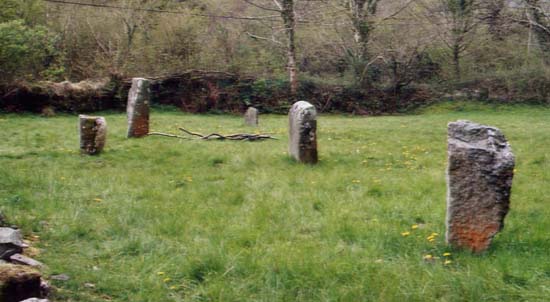
Pillar Stones submitted by PaulM on 24th Apr 2003. The Pillar Stones are a group of four Christianised stones located in a churchyard in the Gwaun Valley in Pembrokeshire (SN123340).
The reverse of each of the stones is carved a cross of differing designs. A fifth stone seems to act as a font.
(View photo, vote or add a comment)
Log Text: Pillar Stones, Cwm Gwaun. These stones were the second of the ancient monuments we saw during our visit to Pembrokeshire, and a great start to our trip.
The five pillar stones were visible from the road, in the grounds of a small chapel, so we parked in the driveway to get off the single track road. It was only when we tried to go into the chapel that we realised it had been converted to a private house and the pillar stones were in the garden.
We were able to make our crosses on three of the stones (inscribed on the sides facing away from the chapel, looking east). I wasn’t sure if there was any particular alignment to the stones; they didn’t particularly appear to have been arranged in rows.
There is also an old font under the bell tower of the church.
Trefach
Date Added: 27th Aug 2014
Site Type: Standing Stone (Menhir)
Country: Wales (Pembrokeshire)
Visited: Yes on 21st Aug 2014. My rating: Condition 3 Ambience 4 Access 4

Trefach submitted by PaulM on 6th Jan 2003. The Trefach Stone.
Please see the Megalith Map site entry for details.
(View photo, vote or add a comment)
Log Text: Trefach, Pembrokeshire. This stone was literally just round the corner from Gellifawr, where we were staying. We parked at the entrance to the field on the corner of the road and walked up to the footpath which leads up to Waun Mawn. There was actually a couple of parking spaces at the bottom of the footpath so we could have driven closer, but after a long car journey, it was nice to put feet to tarmac and grass again.
The footpath rises up a gentle hill, and after a few paces, there was what appeared to be a cairn to the left hand side. Looking up the hill, Trefach became visible on the horizon. There was a clear track leading up to the stone, so we followed this. The stone is surrounded by a low wire fence, presumably to protect it from the stock (in this case a small herd of Welsh ponies, who curiously came to see what we were doing and what food we might have brought!).
The views over the Afon Gwaun Valley to the east were lovely. (as Paul M says in his description of the site: ‘commanding’). To the north west, there were views over crags at what I think is Carn Ingli.
Near the main Trefach stone, there was a fallen stone, which looked as if it might have stood upright. The field was also littered with groups of stones which looked like possible cairns.
This was the start of a couple of hours exploring some pretty interesting sites within the Cwm Gwaun valley.
Glyn Gath Barrow
Date Added: 28th Aug 2014
Site Type: Round Barrow(s)
Country: Wales (Pembrokeshire)
Visited: Yes on 21st Aug 2014. My rating: Condition 2 Ambience 4 Access 5
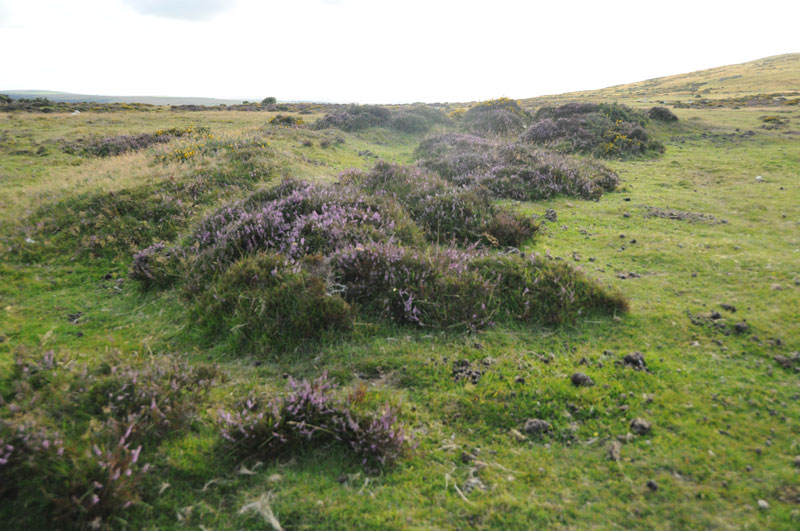
Glyn Gath Barrow submitted by Anne T on 27th Aug 2014. Standing on the bank at the edge of Glyn Gath ring cairn looking northwest.
(View photo, vote or add a comment)
Log Text: Glyn Garth Ring Cairn, Pembrokeshire: After visiting a series of standing stones on the northern side of the Afon Gwaun river, we headed eastwards back towards the hotel at Gellifawr. We passed directly by the Glyn Garth ring cairn, so stopped to take a look.
Even with a detailed map, without the marker stone, we wouldn’t have been able to easily identify this cairn, but walking into the heather and gorse we could make out the perimeter banks (easier to do this with the eye than demonstrate with the camera – I’ve yet to learn the technique to do this well).
It was an impressive location; With Myndd Dinas behind and Newport Bay to the north, this was a fantastic place to be buried.
On the drive southwards from Glyn Garth to Pontfaen, we were doing double-takes at most field entrances, as the gateposts all seemed (to our novice eyes) to be standing stones which had been perhaps been relocated and recycled.
Also of notes to future visitors, it is well worth popping into the Dyffryn Arms at Pontfaen. It is like walking back into time; the main bar is like small sitting room from the 1930s and the landlady serves ale from jugs from a serving hatch – brilliant!
Parc y Meirw
Date Added: 28th Aug 2014
Site Type: Stone Row / Alignment
Country: Wales (Pembrokeshire)
Visited: Yes on 21st Aug 2014. My rating: Condition 3 Ambience 4 Access 4

Parc y Meirw submitted by PaulM on 24th Aug 2001. PARC Y MEIRW STONE ROW, Pembrokeshire
NGR: around SM99893591 (Landranger map 157/Outdoor Leisure North Pembrokeshire map (No 35))
Four stones remain of this row - two of which make up gateposts - the other two are upright in the hedge that borders the road. The Outdoor Leisure North Pembrokeshire map marks only three but two further stones are located ~300m to the south east. Other stones can be seen or make up the roadside bank.
The gateposts look quite square unlike the other two s...
(View photo, vote or add a comment)
Log Text: Parc-y-meiry standing stones, Pembrokeshire: After having visited the Llanllawer Holy Well, we set off eastwards up the road towards Trellwyn farm, where there were two sets of standing stones marked on the southern side of the road.
Driving slowly up this single track lane, trying to look over the tall banks and fences rising above us on either side of the road to spot the stones, a tall standing stone by a field gate suddenly appeared, looming above us from the grass verge – impressive!
We stopped the car in the gate entrance and hopped out to take a look. Only the large stone There was nothing in the field, so we unlatched the field gate to take a closer look.
Unusually, I haven’t been able to find out much about these stones, apart from a short entry on the Royal Commission on the Ancient and Historical Monuments For Wales, where the stones are referenced as SAM PE126.
Trellwyn-fach Stone Pair
Date Added: 28th Aug 2014
Site Type: Standing Stones
Country: Wales (Pembrokeshire)
Visited: Yes on 21st Aug 2014. My rating: Condition 3 Ambience 3 Access 4
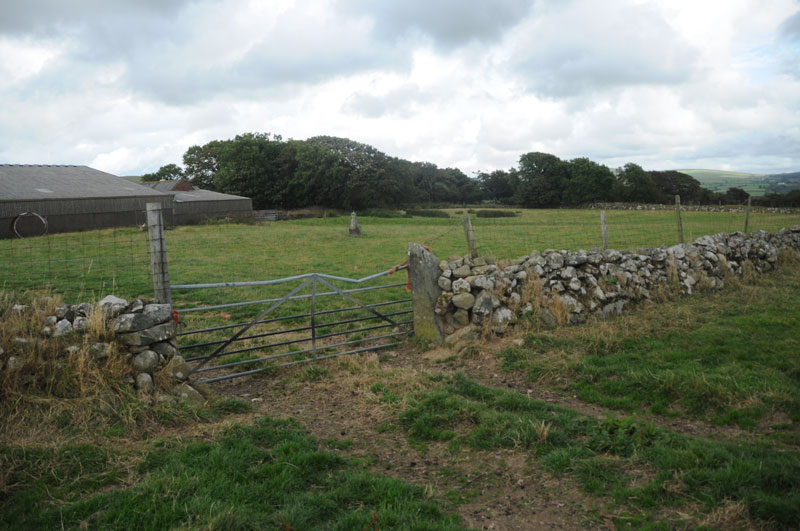
Trellwyn-fach Stone Pair submitted by Anne T on 28th Aug 2014. This photograph shows the two stones in context of their immediate landscape. The first stone is being used as the gatepost, the second is visible between the gatepost and the barns, more or less in the centre of the photograph.
(View photo, vote or add a comment)
Log Text: Trewynfach (Tre-llwyn Fawr) Stone Pair, Pembrokeshire: About 400 yards up the road from the Parc-y-meirw stones, just before reaching a house called Trellwyn, is an un-named farm to the south side of the road. On the map there are two standing stones marked, which stand very slightly to the west of the farm. Neither of the stones can be seen from the road. No-one appeared to be at the farm, and as the field gate was open, we walked along the field boundary for about 50 yards to see if we could spot them.
One of the stones has been used as a gatepost, in the field boundary between the farm and the first field to its west; the other is situated in the middle of the farmyard. Presumably the gatepost stone, which stands 1.4 metres high, has been relocated from its original site. The second stone is on private land, but looks taller than the stone being used as the gatepost.
I confess that after the Parc-y-Meirw stones and these, we looked at the gateposts of all the farms as we drove along, wondering if they were ‘recycled’ standing stones.
Trellwyn-fach
Date Added: 28th Aug 2014
Site Type: Standing Stone (Menhir)
Country: Wales (Pembrokeshire)
Visited: Yes on 21st Aug 2014. My rating: Condition 3 Ambience 4 Access 3
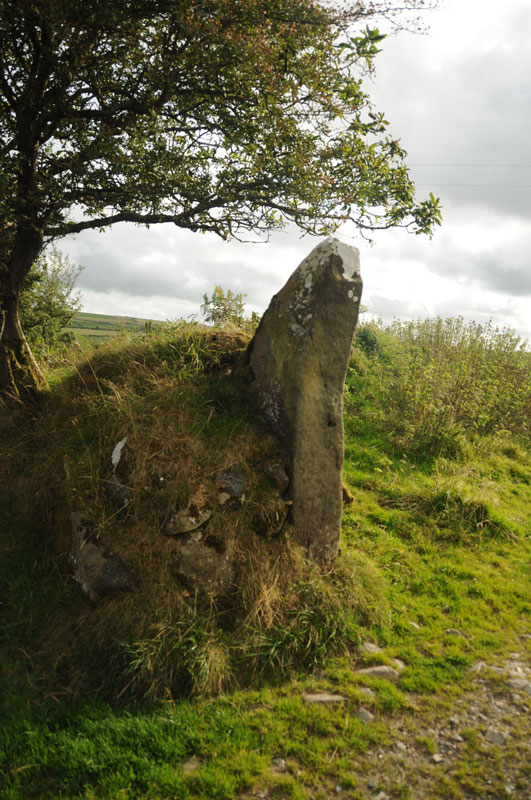
Trellwyn-fach submitted by Anne T on 28th Aug 2014. There were many larger stones buried in the banks defining the fields, and I wondered if this was another standing stone ....
(View photo, vote or add a comment)
Log Text: Trellwyn-Fach Standing Stone, Pembrokeshire: [We found more than one standing stone at this site, one of them not marked on the map, so I hope I haven't confused them – if I’ve got it wrong, please let me know so I can correct my entries (thank you!)].
From the Trewllyn-Fach Stone Pair, we walked along the footpath at the other side of the un-named farm (about 100 yards south west of the house called Trellwyn). This is essentially a farm-track and easy walking, past old farm properties which are being renovated. As the track turned a left hand corner just past the farm buildings, I spotted a standing stone in the middle of the field, but this wasn’t marked on the map, so intrigued, we continued onto Trellwyn-Fach.
The footpath went passed the standing stone towards the derelict Trellwyn-fach farmhouse, but there was a well-worn track across to the stone, so we crossed the bank forming the field boundary and followed the track to take a closer look at the stone. On the way, there was also another erratic stone in the field to the left hand side (I’ve not been able to get the grid reference as the images from UK Grid Finder are those of clouds, so I’m unable to make out the ground). The whole area is littered with large stones, possible cairns and what appear to be large erratic stones.
I wasn’t sure if the stone had broken and the broken piece been taken away, or if the rock had been deliberately quarried. This stone does indeed look like a pointing finger and there are good views over the Cwm Gwaun valley.
Tre-llwyn Fawr
Date Added: 28th Aug 2014
Site Type: Standing Stone (Menhir)
Country: Wales (Pembrokeshire)
Visited: Yes on 21st Aug 2014. My rating: Condition 3 Ambience 4 Access 4
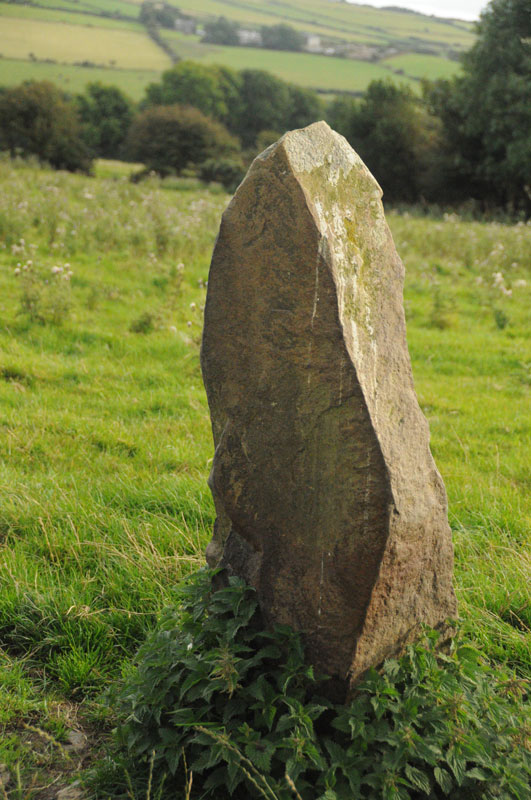
Tre-llwyn Fawr submitted by Anne T on 28th Aug 2014. Continuing the quick walk around the stone to look at it's other faces. There was a smaller stone buried in the grass to the west, but this hasn't been picked up the camera, as it lies too low to see clearly.
(View photo, vote or add a comment)
Log Text: Trellwyn-Fawr Standing Stone, Pembrokeshire: [We found more than one standing stone at this site, one of them not marked on the map, so I hope I am reporting them correctly – if I’ve confused them, please let me know so I can correct my entries (thank you!)].
On the way back to the road from the Trellwyn-Fach Standing Stone, we stopped off to look at this stone, which we'd first seen on the walk down. This stone stands alone in the middle of the field, with great views over the Cwm Gwaun valley below. It seems to fit the description on the Dyfed Archaeological Site, which describes this stone as 1.4 metres high by 1 metre wide at its base, leaning slightly to the north-north-west. Just to the west, there was another smaller stone poking through the grass.
The views to the north, east and west were blocked by hedges and trees, so it wasn’t really possible to appreciate the location this stone was set in.
St Gwyndaf Stones
Date Added: 28th Aug 2014
Site Type: Early Christian Sculptured Stone
Country: Wales (Pembrokeshire)
Visited: Yes on 22nd Aug 2014. My rating: Condition 3 Ambience 4 Access 4

St Gwyndaf Stones submitted by vicky on 8th Jun 2004. One of the five 7th-9th century decorated stones in the exterior walls of Llanwnda Church. This one is decorated with a face beneath the cross of St Andrew.
(View photo, vote or add a comment)
Log Text: St Gwyndaf’s Church, Llanwnda with stone crosses: Husband, Andrew, and I were both intrigued by Vicky’s description of the St. Gwyndaf Stones on the Portal, so after a busy day exploring the St David’s area, we decided to stop off in Fishguard for dinner, taking a detour to Llanwnda on the way.
Despite having a detailed map, we got lost twice, taking the wrong lane and ending up back on the main road, then taking the left hand turn inside of the right where the road splits within Llanwnda village, and ending up at someone’s house and having to reverse down a particularly narrow, windy single track lane, being watched by a curious local lady who came out to watch.
After that, we found the church easily enough. There were even a few parking spaces just by the path leading down to the church. A very pretty spot, although feeling incredibly remote, overlooking the sea.
The whole of this site has a huge sense of age and heritage. The inside of the church is simple, but impressive. There was no church guide available to look at, but there was a copy of the ‘Saints and Stones’ book telling us something about the church. Page 7 of this books tells us: “on the window-sill near the font is a fragment of a medieval stone showing a bishop administering a blessing and holding a staff; it may have been part of an ancient churchyard and cross. Another stone fragment of the same date can be seen on the first window-sill in the south wall. In the chancel is a case containing a copy of the Welsh ‘Parry’ Bible (1620) [although this is well-used and falling apart – impressive non-the-less] .... No fewer than six 7th-9th century Christian marked stones were also discovered in 1881; five of them are set into the exterior walls of the church. Once part of the larger structures, they were carved by stonemasons working under monastic patronage. The most fascinating of these is set into the east end of the south transept. It shows a rudely incised face surrounded by four parallel lines beneath the cross of St. Andrew; the face may be that of a female, a monk or Christ-as-Procrator. High in the south wall is a stone marked with a double-outline cross and another in the east wall of the chancel is decorated with a Latin cross. A fourth stone in the north wall displays a double Latin cross enclosed by a rounded outline, and low in the south wall to the west of the porch is a stone of later date (probably 10th century) with a moulded cross. The base of a decorated cross lies on the north-west side of the churchyard.”
We spotted the five stones set in the wall and the two on the window-sills, but failed to see the cross in the churchyard.
I’d recommend anyone in the area to take an hour to find this church and the stones – a true sense of history and occasion contained within this tiny building and surrounding church yard.
On the next visit, must ensure to take in the Garnwnda Burial Chamber and nearby standing stone.
St Non's Well (Pembrokeshire)
Date Added: 29th Aug 2014
Site Type: Holy Well or Sacred Spring
Country: Wales (Pembrokeshire)
Visited: Yes on 22nd Aug 2014. My rating: Condition 4 Ambience 4 Access 4
St Non's Well (Pembrokeshire) submitted by chestertourist on 27th Dec 2004. St Nons Well near St. David's.
(View photo, vote or add a comment)
Log Text: St Non's Well, Pembrokeshire: It was interesting trying to find the small road leading down to St. Non’s Chapel and Well; it turned out to be a side road off a side road, with a very, very narrow section coming out of St. David’s.
This road led down to St. Non’s Retreat Centre, with views over the sea. Just before the road reached the Retreat Centre, there was a small car park on the right hand side, with plenty of room for visitors, with only a short walk down to the well and chapel.
Approaching the well, my first view was a stone vault to the right hand side, with a white statue of a woman with her arms outstretched, and at first I thought this was St. Non’s Well. The actual well is a few steps further on to the left hand side. As we stepped down to see the source of the water, there was a continuous noise, like the well was connected to a blow hole at the bottom of the cliffs with the noise of the waves lapping at the entrance coming back up where we stood. We stood in silence, listening. “The well’s breathing!” I exclaimed. After a few more minutes, I realised that the noise came from the bullocks drinking from the small stream of water that emerged from the well into the adjacent field. Not a holy miracle after all, but it got the heart racing none-the-less.
We went onto explore St. Non’s Chapel and the standing stones in the same field, hopping onto the Coast Path (well my husband did – I couldn’t get over the stone stile in the south-western corner of the field, because of the proximity of the path to the drops down to the sea below). We watched a school of kayakers in the bay below, with blue sky and spectacular geology. I would have loved to have taken a flask of tea and just sat for a while taking this all in.
Whilst we were exploring the standing stones around the chapel, I noticed a family collecting water from the well.
St Non's Chapel
Date Added: 29th Aug 2014
Site Type: Early Christian Sculptured Stone
Country: Wales (Pembrokeshire)
Visited: Yes on 22nd Aug 2014. My rating: Condition 3 Ambience 4 Access 4
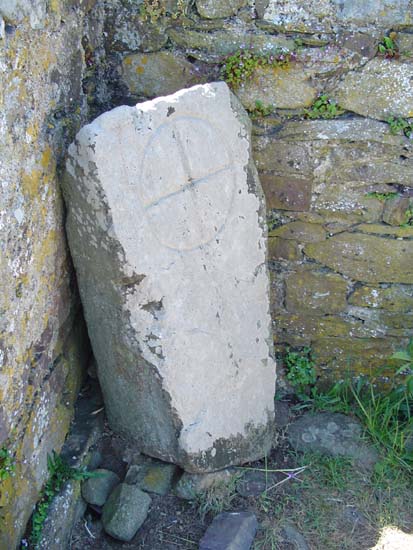
St Non's Chapel submitted by vicky on 7th Jun 2004. Within the ruined chapel of St Non's, around which are the remains of a possible stone circle, lies this inscribed stone. It is believed to date from the 7th-9th century AD and is decorated with a ring cross.
(View photo, vote or add a comment)
Log Text: St Non's Chapel, Pembrokeshire: A gate leading from between St Non’s Well (to our left) and the vault with her statue in (to our right), led into the field containing the chapel. It was a short walk to the ruined building, which is enclosed by a fence to protect it from the cattle in the field.
This chapel is very small, with an entrance to the west side. It is on a very steep site, and the walls to its southern side are composed of some impressively large stones.
Inside the chapel is a small white-painted cross, in the left hand corner as you face the sea. At its base are many offerings – tokens, tea-lights, a small memorial plaque and pebbles painted with people’s names.
Whilst we explored the stones in the field around the chapel, a Welsh family came and spent quite some time by the cross, and I wondered if they were laying their own offerings. This is certainly a superb spot to mediate and pray on a sunny day.
As we entered the field, it was apparent that there were some standing stones within the field, although I’d not seen these referred to until I logged onto the Portal when we got home. I’ve submitted some images of these along with the chapel.
Tremaenhir Standing Stones
Date Added: 29th Aug 2014
Site Type: Standing Stones
Country: Wales (Pembrokeshire)
Visited: Yes on 22nd Aug 2014. My rating: Condition 3 Ambience 3 Access 5
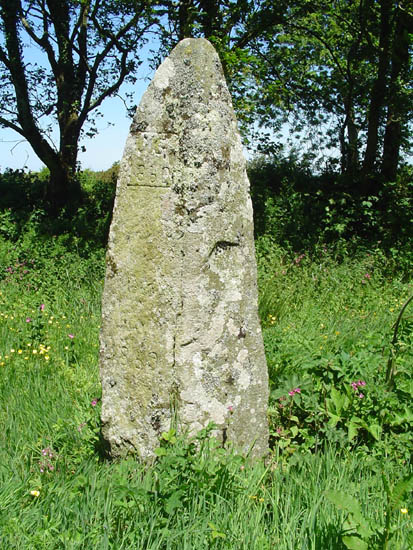
Tremaenhir Standing Stones submitted by PaulM on 6th Jun 2004. The village name suggests there are three standing stones in this village. This is the second of two marked on the OS map.
It is handily located on the grass verge so you can walk right up to it or view it from the comfort of your car seat.
This stone is located at SM827263 and has the initials "J.G." carved into it with the date 1860.
(View photo, vote or add a comment)
Log Text: Standing Stone by Tremaenhir, Pembrokeshire: After an amazing day at St. David’s Cathedral and Bishop's Palace, followed by St. Non’s Well, Chapel and standing stones, we were reluctant to call an end to the day, so we decided to drive along the A487, heading north to Tremaenhir Farm, where the map told us there were ‘Standing Stones’.
Just opposite the farm, there was a solitary tall standing stone, with only its top half poking above the undergrowth. We looked around for more, and couldn’t find any - although I did spot a tall shape in the bank opposite, which looked like it could have been a standing stone heavily covered by ivy.
It would be fun to go back in winter, when all the grass and weeds have died down, armed with the information and grid locations recorded here on the Portal.
Hogtivis Stone
Date Added: 28th Aug 2014
Site Type: Early Christian Sculptured Stone
Country: Wales (Pembrokeshire)
Visited: Yes on 23rd Aug 2014. My rating: Condition 3 Ambience 4 Access 4
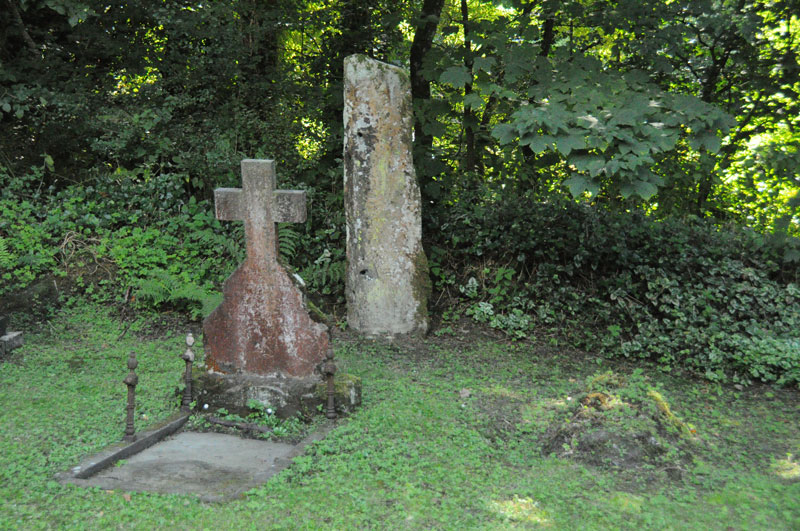
Hogtivis Stone submitted by Anne T on 25th Aug 2014. Photograph showing the location of the Hogtivis Stone from the west end of the church. It is nestled snuggly against the boundary bank of the church yard and the car park, between grave stones.
(View photo, vote or add a comment)
Log Text: Intrigued by just the word ‘Stone’ on the map, we drove from Garnturne burial chamber towards Sealyham Bridge, looking for the church next to ‘The Stone’. There are just a few farms and an outdoor centre here; it is a very pretty little spot. Just before the bridge over the river Afon Anghof, there was a small cark park (surrounded by overhanging trees on three sides) on the right hand side of the road. The church was invisible, being hidden by these trees, so we ended up driving past, turning round and going back. Turning into the car park, the top of the church and the gateway into the church yard immediately became visible.
This was one of the smallest churches I’ve come across. The wrought iron gate to the church spelled out the year 1870, and the church did indeed look relatively modern; but looking closer, there appeared to be a tiny chapel embedded in the larger building which looked much, much older. The church was locked, so sadly we couldn’t get in, as I would have loved to look round the interior of the building, and there was no contact telephone number to call to arrange a visit. Doing some research on arriving home, I found out that the nave and south aisle were separated by Norman arches, which I would love to have seen.
The churchyard was also tiny, largely dominated by wrought iron railings surrounding a large family plot immediately to the south of the church, by the porch. The two bells were rung by ropes coming down the exterior west end of the building.
In the corner of the churchyard, lodged snuggly against the bank between the church yard and the car park, and tucked between two graves, was The Stone. It had obviously been used as a gatepost at some time, with several holes, some still containing metal pins (my immediate reaction was ‘poor thing’). There were obvious signs of carving on the right hand side of the front face of The Stone which looked like Ogham, plus some other possible carving to the left, which the records tell me is a Latin inscription. Funnily enough, the camera was able to pick out the Latin inscription better than my eye, as recorded in the image submitted here.
The Archaeological Data Service record states that the stone is 5th or 6th century, and “was found in 1897 'a few hundred yards' from Little Treffgarne farmhouse. If it was in situ, then it may have been associated with the monastic site of Little Treffgarne”.
This site is only a couple of kilometres from the A40, east of the village of Wolf’s Castle, and 9 miles north of Haverfordwest. The Genuki website saying this parish is traditionally known and the birthplace and burial place of Owain Glyndwr who “is said to have been born at Little Trefgarn and to have been interred at the small village of Wolf’s Castle’.
Bedd Morris
Date Added: 26th Aug 2014
Site Type: Standing Stone (Menhir)
Country: Wales (Pembrokeshire)
Visited: Yes on 23rd Aug 2014. My rating: Condition 3 Ambience 3 Access 5
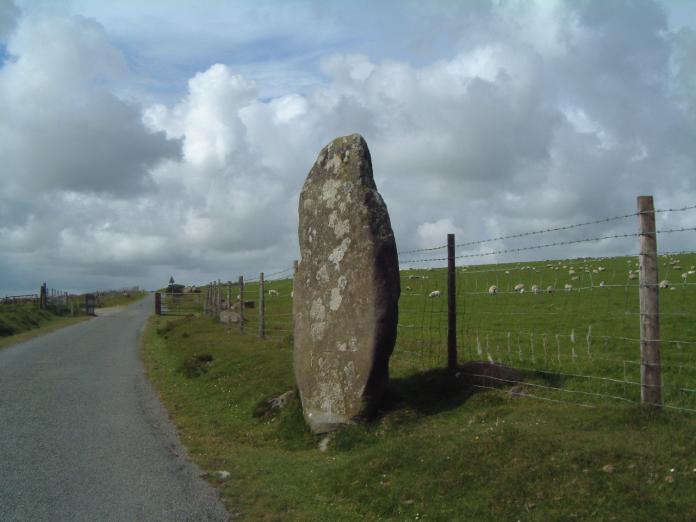
Bedd Morris submitted by enkidu41 on 3rd Jun 2004. SN 0382 3650
A 6'6" high menhir which tapers to a point.
(View photo, vote or add a comment)
Log Text: I spotted this standing stone by the right hand side of the road as we were driving over the Ffordd Bedd Morris road from the A487 towards Cwm Gwaun, where we were staying for a few days. After an eight hour journey, and with the rain coming down in huge droplets, we drove past and returned on the way back home to take a closer look.
Bedd Morris is very easy to find, being opposite the main car park for walkers at the top of the hill. Whilst impressive, it’s hard to believe this stone is still in its original location. There are professionally carved inscriptions on the stone, leading us to believe it is now being utilised as a boundary marker. Looking this up on the return home, the Bedd Morris record on the Archaeological Data Service web site confirms this stone is used as a marker between the parishes of Llanychlwyddog and Newport.
Their site also goes onto say that the stone fell over and broke, probably after being hit by a vehicle (hence the protective stones either side) and was repaired and re-erected in 2012.
There is also a trig point carved into the front of the stone, next to some graffiti.
We were on our way home, with an 8 hour journey in front of us, and other places we wanted to see, otherwise it would have been really nice to have done some walking in this area – the location just screamed at me to get my walking boots on.
Driving northwards towards Newport, there are splendid views of Dinas Head and Newport Sands from the viewpoint further along the road.
Pentre Ifan
Date Added: 27th Aug 2014
Site Type: Portal Tomb
Country: Wales (Pembrokeshire)
Visited: Yes on 23rd Aug 2014. My rating: Condition 3 Ambience 5 Access 4

Pentre Ifan submitted by PaulM on 24th Aug 2001. PENTRE IFAN CHAMBERED LONG CAIRN WITH FORECOURT
NGR: SN09953702 (Landranger map 145/Outdoor Leisure North Pembrokeshire map (No 35))
Located 4km east of Newport on a public footpath. One of the most spectacular and famous monuments of its type it consists of a tilted capstone perched on three uprights. A blocking stone obstructs the doorway and a semi-circular forecourt is found at the southern end. Originally covered by a huge long mound - traces of possible kerbstones can still be fou...
(View photo, vote or add a comment)
Log Text: Pentre Ifan, Pembrokeshire: I was particularly excited to go to the site, as I’d seen many photographs and paintings of Pentre Ifan during our brief visit to Pembrokeshire, together with photographs on the Portal. I was unprepared for the sheer number of visitors who came to see this spectacular burial chamber. However, everyone seemed to respect others need to take photographs and kept out of each other’s way, which was nice. We also got into conversation with a Japanese lady about how they had raised the cap stone.
I was truly amazed at how the cap stone balances on the pointed tips of just three uprights. All around are larger stones which may have been part of the structure in the past.
The views over to Newport sands and the sea are wonderful. I would like to go back to the site at a quieter time and just sit and absorb it.
Trefael
Date Added: 27th Aug 2014
Site Type: Rock Art
Country: Wales (Pembrokeshire)
Visited: Saw from a distance on 23rd Aug 2014
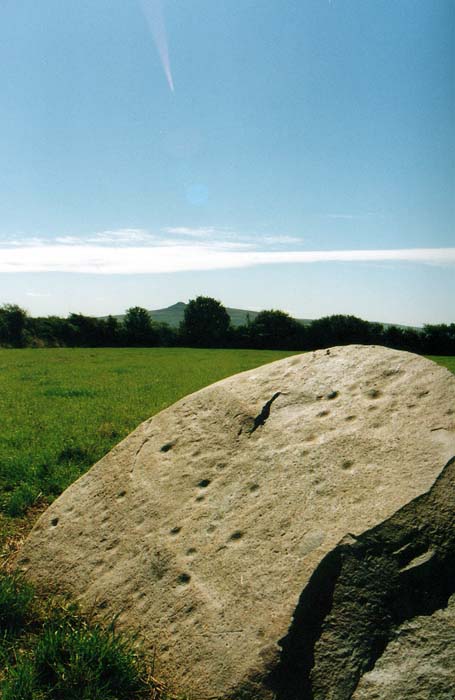
Trefael submitted by PaulM on 17th Aug 2002. This cup-marked stone stands in a field near Trefael at SN10294028. See main site entry for more details.
(View photo, vote or add a comment)
Log Text: Trafael Rock Art, Pembrokshire: We were looking forward to seeing this rare example of rock art in Wales, but despite driving up and down the B4582 road twice, we couldn’t find any of the marked footpaths. We could identify from the field pattern from our detailed map exactly where the stone was located. I suggested going to Bayvil church, further down the footpath, and walking back from there. On our second drive-past, we saw a very clear, official notice on the gate to the field saying ‘access to the capstone only with the permission of the landowner’. As we will have to research who the landowner is, we’ll need to save a visit to this rock art for another time.
However, we were well compensated by stumbling upon Nevern church with its stone crosses a few minutes later.
Gors Fawr Stone Circle
Date Added: 28th Aug 2014
Site Type: Stone Circle
Country: Wales (Pembrokeshire)
Visited: Yes on 23rd Aug 2014. My rating: Condition 4 Ambience 5 Access 4
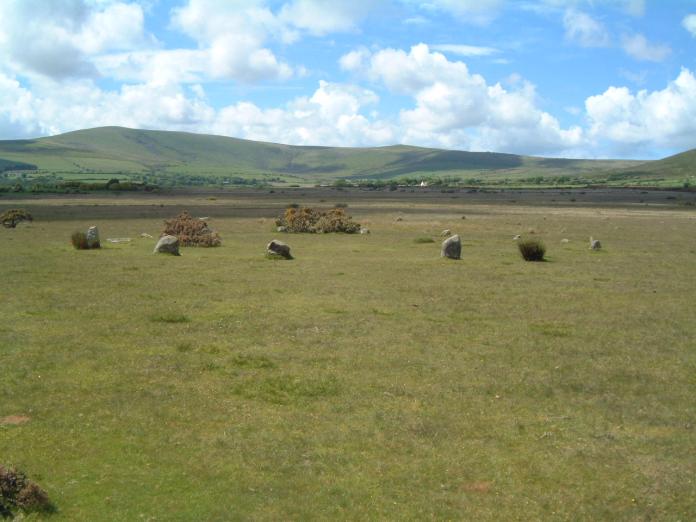
Gors Fawr Stone Circle submitted by enkidu41 on 3rd Jun 2004. A circle of 16 stones in an almost perfect 73’ diameter circle. This shot proves that it's not always wet in Wales.
(View photo, vote or add a comment)
Log Text: Gors Fawr Stone Circle, Pembrokeshire: After stopping off at St. Brynach’s church in Nevern to see the stone crosses, we started on our long journey home to Northumberland. We’d identified a number of ancient sites we wanted to see on our way back, including the Gors Fawr Stone Circle. My husband had hoped to see the site in the Presili Hills where they’d quarried the stones for Stonehenge, but time (and my horror of precipices and steep drops) wouldn’t allow – on our next trip, we’ll need to allow another month at least to see all the things we want to in the area!
Following the A478 and turning off towards Mynacholog-ddu at the village of Crymych, it was easy to find the little gem of Gors Fawr. Again, I hadn’t realised what a tourist attraction this was. There was a small lay-by across from the house ‘Pen-rhos’, and an easy walk across the field to the circle.
It was much smaller than I imagined from the photographs I’d seen on the Portal, but if I’m allowed to, I'd use the word ‘cute’ as the most accurate description that comes to mind. One of the first things I saw almost in the middle of the circle was a small Wiccan altar, made of small rounded blue pebbles, with its apex pointing towards the Gors Fawr Outliers.
Walking just outside the perimeter of the circle, we became aware of smaller stones buried in the grass at regular intervals about 3-4 metres outside the main circle, and wondered if there was an outer circle (but then there were so many other stones in the field that we let our imaginations run a little riot with ideas of stone avenues and tumuli). Since I've been home, I've read on the Ancient Wisdom of Wales web site that a survey had been done, and nothing found.
But what a place to build a circle – on a wide, flat plateau of moorland, with the Presili hills rising to the north. This stone circle seeming to lie in the centre of the graceful bowl formed by the hills, which rose up blue and misty in the distance. The circle somehow seemed to me to capture the essence and magnificence of the landscape.
There was a small, constant stream of other visitors. I got into conversation with a family who said they’d had trouble finding the circle, and had stopped by the Outliers and walked back. The man told us about the apparent alignments between the Outliers and the Circle at Solstice, so I’ll need to check this out. I didn't have the courage to ask him if he was another Portal user (but next time I won't be so shy!).
I would have loved to have stayed until sunset.
Gors Fawr Outliers
Date Added: 28th Aug 2014
Site Type: Standing Stones
Country: Wales (Pembrokeshire)
Visited: Yes on 23rd Aug 2014. My rating: Condition 3 Ambience 5 Access 4
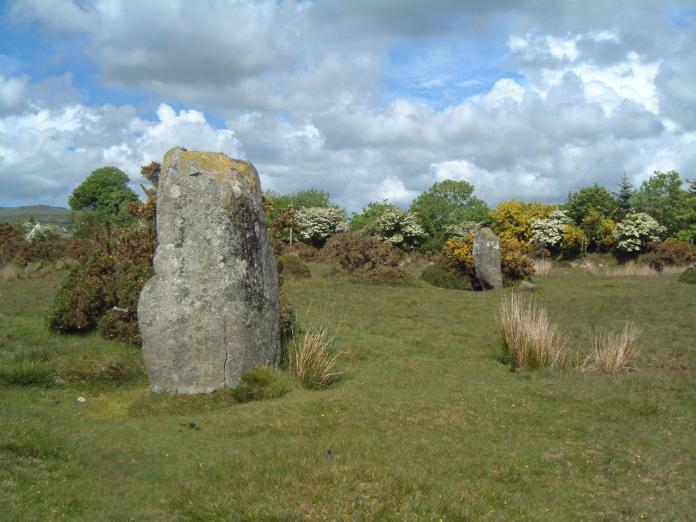
Gors Fawr Outliers submitted by enkidu41 on 3rd Jun 2004. These 6' and 5'7" stones lie 45' apart north-east of the circle. This shot proves that it's not always wet in Wales.
(View photo, vote or add a comment)
Log Text: Gors Fawr Outliers, Pembrokeshire: It was an easy walk of about 150 metres or so north-northeast across the moorland to the Gors Fawr Standing Stones/Outliers, which were visible from the stone circle.
Standing at the Outliers looking towards the circle, they do appear to be an entrance. We spotted other shaped stones lying in the grass, which looked like they may have formed part of a stone avenue at some point in the distant past.
One of the Outlier stones was shaped, as if it could be used to sit on. I understand from reading the Ancient Wisdom of Wales web site that this is called ‘the dreaming stone’ and has magnetic qualities.
With the Presili mountains in the background, I certainly had the sense of an ancient landscape with huge meaning for our ancestors, and wished I could tap into their thinking today.
I am interested in finding out about possible alignments between these Outliers, the circle and the Solstice – once I’ve processed all the photographs and notes I’ve taken from this trip!
